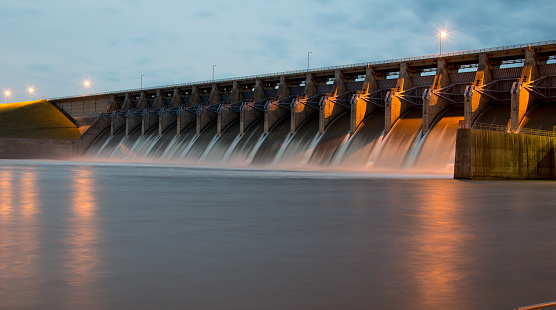In our daily life we encounter many resting objects having gravitational energy due to earth’s gravity which exert a pulling force on each object downwards or because of vertical position of object. This energy is not because of motion of and object, although it get converted into kinetic energy when objects come into motion.
- Water beyond the dams
- A vehicle parked at the top of the mountain of a hill
- A yoyo until it’s launched
- Water from a river flows to the peak of a waterfall
- A book on the edge of slipping off a table
- A child at the peak of a slide
- Destroying mechanism in the shape of a giant ball
- A child swinging
- A ripe fruit until it breaks away from the branch
- A bird perches on a limb of a tree
- A flower pot dangles from the deck
- Airplane flying overhead
- Simple pendulum
Water beyond the dams
A dam is a structure that prevents or restricts the passage of water or subterranean streams. Dams establish ponds that supply water for crops, public sustenance, commercial use, fishing, and transportation, in addition to preventing floods. A dam that retains water at a high elevation contains energy that is converted to another form as the water flows down.
A dam’s role is to seize or hold water, drainage, or liquid-borne pollutants for a variety of purposes, including flood management, domestic supply of water, cultivation, and animal water system, power production, mine wastes confinement, recreation, and control of pollution. Gravitational potential energy is present in the water close to the top in the dam.
As the water rushes down via tubes inside the dam, this energy is converted to kinetic energy. Power stations are being installed inside the dam and will be rotated by the rushing water. As a result, the dam has energy potential. This energy is turned to kinetic energy when it is enabled to move. On the lower level, the dam is significantly wider compared to the upper.
That’s because the water pressure is significantly higher farther down, and the dam must be strong at the bottom to resist the immense pressure. The amount of water over a certain place on the dam’s walls determines the amount of force put to the dam’s walls. As a result of the vast depth, water pressure is quite strong near the bottom. The dam takes on a new form as a result.
A vehicle parked at the top of the mountain of a hill
Assume a vehicle on a slope to analyze potential and kinetic energy of that vehicle. The vehicle does have the highest potential energy whenever it hit the peak of the slope. Its kinetic energy becomes zero when it is resting motionless. Since it goes down the hill, the vehicle expends potential energy and gains kinetic energy.
A yoyo until it’s launched
Potential energy is usually transformed to kinetic energy. Because of its posture, the yo-yo contains energy conserved before it started to drop. The yo-yo has the highest potential energy stored when it is at its peak. Potential energy is transferred to kinetic energy when the temperature decreases.
Its potential energy has been turned into kinetic energy at the base, and it now has the highest kinetic energy. The energy of moving object is known as kinetic energy. Kinetic energy exists in a rubber band travelling through the sky. Whenever we walk or run, we are displaying kinetic energy in your body.
Water from a river flows to the peak of a waterfall
Now let consider the concept of energy preservation to understand from which the energy of dropping water originates. As per the notion, energy cannot be created or eliminated, but only converted from one form to another. Gravitational potential energy exists in the water at the peak of a really steep waterfall. This energy is transformed into kinetic energy when the waterfalls, leading to a high flow.
As the flowing water collides with the quantity of water at the floor of the waterfall, it spurts wildly and carelessly in all directions. Some portion of the kinetic energy obtained by falling water is now turned into randomized movement kinetic energy. As a consequence, the water’s inner energy grows, and the temperature of the water at the base of the falls raises.
A book on the edge of slipping off a table
A book on a table has less gravitational energy than a book on top of a larger office and less gravitational energy than a heavy book on a single table because An material’s length, weight, and toughness have a greater impact on all of its gravitational energy than the comparison point.
When the book is elevated above the ground to maintain it on the table, certain external factors counteract the gravitational attraction. If the book drops to the ground, the force of gravity gives it appealing force. The book dropping from the table receives acceleration owing to gravity, causing the potential energy to be transformed into kinetic energy.
A child at the peak of a slide
If a person rests at the top of a slide for the first time, he or she is packed with potential energy. Potential energy is any energy conserved that may fall or move. It can be found in anything or entity that can fall or move. When the child starts to slip, potential energy is converted to kinetic energy. Kinetic energy may be found in every moving thing. The weight and velocity of an object define the amount of kinetic energy it has.
As a result, the kinetic energy of a person falling down a slide is determined by two connected factors: how much the person weighs and how quickly they are travelling. A person’s kinetic energy is there regardless of which way they are sliding down the slide or at what angle they are sliding.
Destroying mechanism in the shape of a giant ball
The weight and altitude beyond the baseline of an item have a proportional connection with gravitational potential energy. As the object is elevated, its gravitational potential energy develops. The massive weight of the destroying ball and the altitude with which it is lifted determine the gravitational potential energy of the ball.
A child swinging
Take a seat on a swing and allow someone push you. you move away. And how if the guy who shoved you leaves and you wish to swing up much faster? Unless you’ve been in second grade, you already know the answer. One may help himself swing faster by just kicking one’s legs, extending them forward then pulling them up underneath him. Have you ever thought about why this is the case?
Swings function by changing potential energy to kinetic energy and afterwards returning to potential energy. The quick component of swinging is kinetic energy; it’s the pace with which you run back and forth. The highest portion of swinging contains potential energy. The taller you get on the swing, the more energy you have now in reserve.
A ripe fruit until it breaks away from the branch
This basic attraction force attracts all matter to one another. Because it is the smallest known force in nature, it has no effect on the inner properties of regular matter. The weight, or downwards force of gravity, that all bodies on Earth experience is proportional to their mass and is exerted on them by the Earth’s mas
Between both the fruits and the earth, there is a force of gravity at work. As a result, the fruit that has been removed from the tree falls to the earth owing to gravity. When fruit is attached to the branch it contains gravitational potential energy.
A bird perches on a limb of a tree
A bird resting on a branch of tree is at a certain height above the ground. As it is not in motion, it only have potential energy, whereas a flying bird has both kinetic and potential energy. This is due to the fact that it is resting at some height, higher from the earth on the tree.
A flower pot dangles from the deck
A kind of retained energy is gravitational potential energy (GPE). The height at which an entity goes determines the shift in gravitational potential energy. A flower pot hanging off of the deck contains gravitational potential energy because it is hanged at some height with respect to ground.
Airplane flying overhead
When the plane lifts off, the engines give the energy, which is transferred from chemical energy (fuel) to mechanical energy (the spinning of fan blades, or, in some cases, propellers).
Push is produced by the mechanical energy, which enhances the airplane’s velocity. When the airplane’s velocity is raised, mechanical energy is converted to kinetic energy. When the plane travels in elevation, mechanical energy is transformed to gravitational potential energy.
Caused by friction, a significant amount of energy is released as thermal (heat) and acoustic energy during flight. As the plane moves the air around it, some is lost as well. When you land, your drag rises. Kinetic and potential energy diminish as speed and altitude diminish. They are converted into extra heat and acoustic energy in the air, as well as kinetic energy.
Simple pendulum
Mechanical energy is preserved in a simple pendulum with no resistance. Overall mechanical energy is made up of kinetic and gravitational potential energy. Since the pendulum swings backwards and forward on, kinetic energy and gravitational potential energy are constantly exchanged.
The pendulum is briefly immobile at its maximum height. Here really is zero kinetic energy in the pendulum and the entirety of the energy is gravitational potential energy. The pendulum is at its fastest at the lowest position. The pendulum has no gravitational potential energy, so most of the energy is kinetic and that is how total energy stays stable over time.
Frequently asked questions | FAQs
Q. If two objects fall from different heights, one from 5 floor and another from 6th floor, which one will hit the ground with more force?
If two objects fall from various elevations, one from the fifth floor and the other from the sixth floor, one will fall from the fifth-floor window while the other will fall from the sixth-floor window. which one will hit the ground with more force?
The gravitational potential energy of an item increases as it rises in altitude. The longer the distance through which anything falls, the more GPE the object loses as it falls. Because the majority of this GPE is converted to kinetic energy, the higher the object begins, the quicker it will fall when it strikes the earth.
As a result, the height at which an object moves determines the change in gravitational potential energy. So, the object falling from sixth floor will hit the ground with more force.
Q. What is the examples of gravitational energy?
A pendulum is a nice demonstration of gravitational energy since it repeatedly converts gravitational potential energy to kinetic energy.
As the ball reaches the greatest height of the swing, it has zero kinetic energy, yet it has the most gravitational potential energy. Additionally, when the bob descends, gravitational potential energy is converted to kinetic energy, causing the bob to propel.
As a result, the bob’s kinetic energy will be at its most at the foot of the swing, while its gravitational potential energy is at its lowest. The kinetic energy of the bob is converted back to gravitational potential energy because it swings higher. Because some energy is transmitted as heat to the environment, the bob’s swing would fall lower with each swing.
Q. Define gravitational energy?
The potential energy that a huge entity has with respect to some other large object because of gravity is defined as gravitational potential energy.
It is also the gravitational field’s potential energy, that arises as things move towards one another. When the two items are placed close together, the energy increases. The energy that an item has as a result of its location (in a gravitational or electric field) or its state is known as potential energy (as a stretched or compressed spring, as a chemical reactant, or by having rest mass).
Each single matter in the cosmos pulls almost every solid weight with a force that is exactly proportionate to the product of their weights and inversely proportional to the square of the distances among them, according to Newton’s law of gravity.
Q. How potential energy works?
Since power is necessary to lift items over Earth’s gravity, gravitational energy is the potential energy that is key requirement with gravitational force.
Water in an inflated pool or maintained beyond a dam demonstrates gravitational potential energy, which is illustrated by water in an inflated pool or maintained beyond a dam. When an item drops from one point to another inside a gravitational influence, the object’s gravitational potential energy decreases by the same quantity.
Also Read:
- How to calculate energy in a thermocouple
- How to optimize mechanical energy transmission in industrial machinery for energy savings
- Why is energy important in medical physics
- Light energy examples
- Where to find photon energy
- How to design elastic energy based earthquake dampers for buildings
- How do solar panels harness light energy
- How to maximize potential energy conversion in gravity based energy storage systems
- Is kinetic energy conserved
- Example of potential energy to radiant energy
I am Sakshi Sharma, I have completed my post-graduation in applied physics. I like to explore in different areas and article writing is one of them. In my articles, I try to present physics in most understanding manner for the readers.










